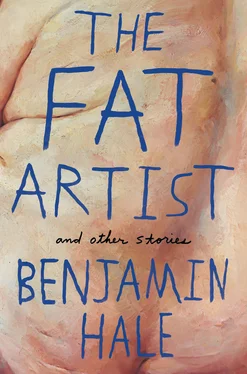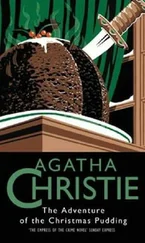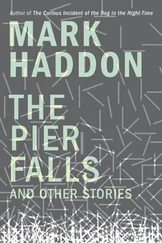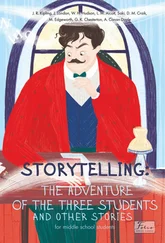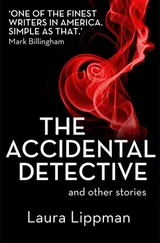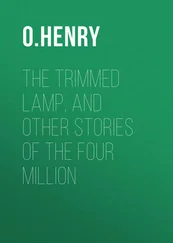• • •
The concept was elegant in its simplicity: to turn Kafka on his head. “A Hunger Artist” in part derives the power of its allegory from the sheer horror of self-abnegation. Why on earth would anyone deliberately starve himself to death? But in a culture of abundance and affordable luxury, bodily self-abnegation no longer retains this primeval horror. Rather, the twenty-first-century middle-class American must actively labor not to become fat. Thus eating becomes moralized behavior. How often have you heard a woman describe a rich dessert as “sinful”? To eat is to sin —in secular society, the body replaces the soul. Good and evil are no longer purely spiritual concepts — these words have been transubstantiated into the realm of the flesh. At other times it seems as if the very process of eating has even become a chore — something associated with work. How often has a waiter at a restaurant asked you if you are “still working ” on your meal? Perhaps eating for us has therefore also been stripped of the especial joy it might retain in a culture in which people are immediately conscious of the threat of want. In a culture such as ours Kafka’s story becomes deflated of much of its sting — we fail to feel the poison of it, because food exists for us in a different psychological space than it did for Kafka: We are a culture that moralizes the diet. Thus “A Hunger Artist” cannot strike its contemporary readers with the same fascination and revulsion. Indeed, far more apropos to an age of overabundance is a Fat Artist.
• • •
And I, Tristan Hurt, the Fat Artist, vowed to become the fattest human being in known history.
As I have said, I was forced by the necessity of objective measurement to equate “heaviest” with “fattest.” Before me, Carol Yager of Flint, Michigan, was widely thought to be the heaviest human on record. Prior to her death at age thirty-four in 1994 from massive kidney failure, Yager was estimated to have peaked at about 1,600 lbs (726 kg). Just below Yager was Jon Brower Minnoch of Bainbridge Island, Washington, who died shortly before he turned forty-two in 1983, having attained a peak weight of approximately 1,400 lbs (635 kg). I, Tristan Hurt, began my journey at a comparatively scrappy 493 lbs (224 kg), which meant I had to gain 907 lbs (411 kg) to even tie for second place, and I had to gain 1,107 lbs (502 kg)— half a ton —to tie the record, though preferably much more if I was to comfortably surpass it. The work I had before me was nothing short of daunting.
The parameters were thus: Anyone could bring me food of any sort — rather, the public was greatly encouraged to bring food — and I would have to eat it. There was but one rule for the visitors, that their offerings had beyond all reasonable contestability to be food —i.e., nothing inedible, impotable, or indigestible. No chewing gum, mouthwash, motor oil, cigarette butts, packing peanuts, cotton balls, chewing tobacco, shaving cream, rubber bullets, small toys, leather, paint, etc. Aside from this one broad guideline, any cuisine was permissible. And there were but two rules I designated to myself, the Fat Artist: (1) any food that is brought to me I must consume; and (2) during museum hours, I must be in the process of consuming (eating or drinking) at all times.
My exhibition chamber also contained a glass table on rollers, long enough so as to stretch wider than the industrial scale beneath my bed, high enough to come up to my midriff when wheeled over the bed, and transparent, so as not to obscure my fat beneath it. My dining table. Waiters were employed. The waiters wore black bow ties and tuxedo vests, and worked in shifts to attend to my dining experience at all times, clearing away my dirty dishes and continually presenting me with more food. The visiting public was to bring me offerings, which the museum workers kept on a table nearby to await their imminent consumption. The table was equipped with heat lamps to keep warm food warm, and a refrigerator underneath it for chilled items. The waiters would bring me the food when I was ready for it and clear away the refuse of whatever I had just consumed.
• • •
The VIP opening of the exhibition was held on a Thursday night in May. It was a beautiful evening. The temperature was consummate, hovering at about 70º F. The museum employees propped open the doors of my exhibition chamber, and the people milled about on the roof, ambling in and out of the open doors of my glass cube. My opening meal was specially prepared under the supervision of Philip Laroux, the chef de cuisine at the West Village’s preeminent three-Michelin-star restaurant, Pleonexia. Laroux also supervised the preparation of the hors d’oeuvres that were arrayed on a long table on the roof outside my glass exhibition chamber. The theme of the evening was food, and thus naturally I demanded that the hors d’oeuvres represent the height of culinary excellence. The hors d’oeuvres table was laden with colorful displays of foie gras, crystallized seaweed, oyster vinaigrette, carpaccio of cauliflower with artichoke and chocolate jelly, scallop tartare and caviar, white chocolate velouté, braised rabbit dumplings in broccoli ginger sauce and chili oil. The centerpiece of the display was an ice champagne fountain, 3D printed after my deliberately garish design: Five female nudes lay basking in sumptuous repose around the base of the fountain, which sloped curvilinearly upward into a deep bowl; the sides of the fountain’s bowl were studded with five erect penises carved from ice and complete with testicles; the fountain was filled with a great quantity of champagne, which tunneled through the hollow flutes of the ice penises and squirted in smooth golden arcs into the open mouths of the five nudes at the base of the fountain; the champagne gargled and frothed in their icy mouths and dribbled down their chins into the lower basin, where it was thrust back into the fountain bowl by a recirculating pump. The guests would catch the champagne by holding their glasses under the streams jetting from the constantly ejaculating penises of ice.
Meanwhile, for added effect, a string quartet played Eine kleine Nachtmusik in continual repetition. Achingly beautiful clothes abounded. Some people wore designer gowns and others, ripped neon mesh T-shirts. Jewelry flashed at slender throats. A photographer slithered through the interstices between bodies with his camera slicing at the night with blank razors of light. High heels clapped on the asphalt surface of the roof. Wineglasses tinkled. Hands shook hands, bodies embraced bodies, lips kissed cheeks. New inamorata were introduced to friends and colleagues. As the string quartet played, mellifluous songs of lovely female laughter rose and fell amid the burble of general conversation, in incidental accompaniment to the violins lacing their high sweet notes through the luscious velvet of the viola and the cello.
The roof of the 1992 addition to the Guggenheim was never designed as an exhibition space. We could not have constructed the exhibit on top of either of the two smaller towers included in Frank Lloyd Wright’s original building because they were not big enough, and we demanded the exhibit be constructed outside, for important aesthetic reasons I do not presently recall. Pipes, antennae, ductwork, and unsightly things like that crawl out of the hot, tar-spattered surface of the flat rectangular roof, and there really isn’t much room to move around. Before the opening, certain cautionary procedures were taken to assure the safety of the patrons, including a temporary guard railing to keep people from straying too close to the edge of the building. All night people awkwardly squeezed past airshaft ducts while trying not to dirty their clothes or spill their drinks.
Читать дальше
